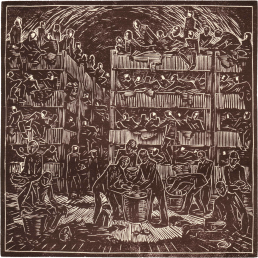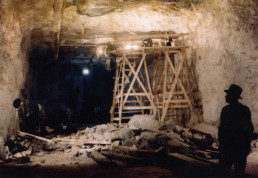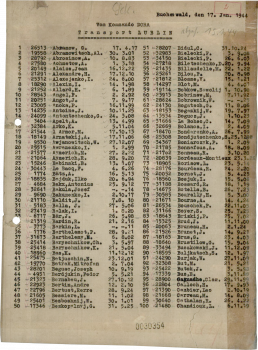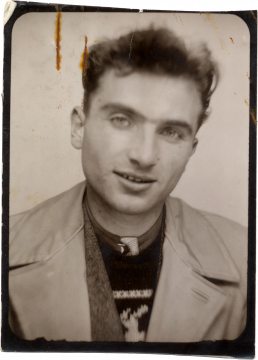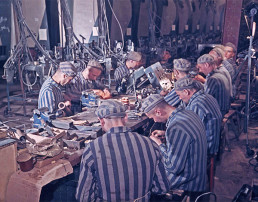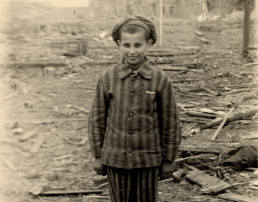Trapped underground:
The tunnel expansion
The first transports to leave Buchenwald for Mittelbau-Dora in the fall of 1943 included several young people. Almost all of them were political prisoners.
Until the spring of 1944, the prisoners in the Dora subcamp worked on the extension of the tunnel system to accommodate the underground rocket plant. Assembly of the A4/V2 rockets began at the Mittelwerk in early 1944. The concentration camp prisoners worked both on the expansion of the tunnel system and in production.
In the first months, the prisoners were not housed in barracks, but underground in sleeping chambers. Thousands fell victim to the catastrophic hygienic conditions in the tunnel and the exhausting forced labor.
Dominik Černý: K.L. Dora: Bydlení ve štole (Dora Concentration Camp: Living in the Tunnels). Woodcut, print from the series K.L. Dora-Sangerhausen, 1953.
Dominik Černý was a Czech teacher and artist. After his liberation, he processed his impressions of the conditions in the tunnels in a series of woodcuts. They express the confinement, darkness, hygienic conditions, and the death of his fellow prisoners.
(Mittelbau-Dora Memorial)
Testimony on forced labor in the tunnels: Franz Rosenbach in an interview with the USC Shoah Foundation, October 1998.
Franz Rosenbach, a Sinto who was 16 years old when he was sent to Dora from Auschwitz-Birkenau via Buchenwald in April 1944. He was a forced laborer in the work details expanding the tunnel system.
(Visual History Archive)
From the tunnel into death: excerpt from the transport list from the Dora work detail to Lublin, 17 January 1944.
The SS sent those prisoners who could no longer work due to illness and exhaustion to die in the Lublin-Majdanek and Bergen-Belsen Concentration Camps. Among them were young people like the 18-year-old Jean Antoine and the 17-year-old Felix Le Bacq, numbers 13 and 24 on the list. The trails of the two French teenagers end in the Majdanek Concentration Camp.
(Arolsen Archives)
"I send for Gouju, my countryman, to come to the 'box' where I lie. He comes, and to see this friend from the good old days near me fills me with inestimable joy; this friend who will faithfully convey my last words and my last thoughts to my father. This is a consolation not had by many who, in the midst of indifferent strangers, died alone in some hut in these accursed camps."
Account by Michel Fliecx of the days before his transfer to Bergen-Belsen, 1946.
The Frenchman Michel Fliecx was a political prisoner and 19 years old when he was sent to the Dora camp in October 1943. In March 1944, the SS classified him as unfit for work and transferred him to the Bergen-Belsen Concentration Camp on an “invalid transport.” He was one of the few survivors.
(Vom Vergehen der Hoffnung. Zwei Jahre in Buchenwald, Peenemünde, Dora, Belsen, Göttingen 2013)
Children in the Mittelbau-Dora Concentration Camp
From rocket plant to construction company: The Mittelbau-Dora Concentration Camp
After a British air raid on the Peenemünde Army Station, the Ministry of Armaments ...
Transferred from Auschwitz to the Harz Mountains: Jewish, Sinti and Roma children
The evacuation of the "gypsy family camp" in Auschwitz-Birkenau began in April 1944.
